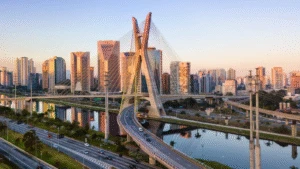5 Ways to Make Your Business Travel Policy More Sustainable
A well-designed travel policy can significantly reduce a company’s carbon footprint while supporting long-term cost savings and employee satisfaction. Sustainability is no longer a nice-to-have—it’s a necessity. Companies around the world are rethinking how they approach corporate travel, balancing employee needs with environmental impact. With business travel responsible for about 50%–70% of a company’s carbon emissions, a well-designed sustainable business travel policy can significantly reduce a company’s footprint while supporting long-term cost savings and employee satisfaction.
Here are five practical ways to make your business travel policy more sustainable.
1. Prioritize Low-Carbon Travel Options
One of the most effective ways to cut emissions is by choosing lower-impact modes of transport. Air travel contributes significantly to carbon emissions, with short-haul flights producing more CO2 per mile than long-haul flights due to inefficient fuel consumption during takeoff and landing. Whenever possible, companies should encourage employees to opt for:
- Train travel: A Eurostar train journey from London to Paris emits 90% less CO2 than a flight on the same route.
- Carpooling and electric vehicles (EVs): Rental companies are expanding their EV offerings, making it easier for employees to rent electric cars for business trips.
- Direct flights over layovers: Non-stop flights use less fuel per mile than multi-leg trips, reducing overall emissions.
- Public transit: Encouraging employees to use subways, buses, or shared mobility services for short-distance travel.
Example: In 2023, Salesforce introduced a carbon budget for flights, setting an annual limit on emissions per employee. This policy led to a 21% decrease in travel-related CO2 emissions in just one year.
2. Partner with Sustainable Hotels to Strengthen Your Corporate Travel Policy
Hotels account for nearly 1% of global emissions, and their sustainability practices vary widely. Companies can embed sustainability into their travel policies by prioritizing eco-friendly hotels that:
- Hold Green Key, LEED, or EarthCheck certifications
- Use renewable energy sources
- Offer water-saving initiatives like towel and linen reuse programs
- Reduce single-use plastics in rooms and dining areas
Example: Many global firms, including Unilever, have adopted a preferred vendor list that only includes hotels meeting stringent sustainability criteria. This ensures employees stay at eco-conscious properties, reinforcing corporate sustainability commitments.
Tip: Employees booking through Dyme Travel can easily find hotels that support renewable energy projects, making sustainable choices effortless.
3. Set Up a Carbon Tracking and Reduction Strategy
Tracking and measuring emissions is key to improving sustainability. Businesses can integrate carbon tracking tools into their corporate travel platforms to monitor and manage CO2 output per trip. Some effective strategies include:
- Using real-time carbon calculators when booking travel
- Establishing an annual CO2 budget per employee
- Providing incentives for lower-carbon travel choices, such as reward points or extra PTO for employees who minimize air travel
Example: PwC uses a dashboard to track CO2 emissions per trip and provides employees with feedback on the environmental impact of their travel decisions. Over time, this data-driven approach has reduced their total travel-related emissions by 30%.
4. Encourage Virtual Meetings and Hybrid Work Policies
The shift toward hybrid work has proven that many business trips can be replaced with virtual meetings. Companies can reduce unnecessary travel by:
- Implementing a virtual-first approach for meetings under a specific duration or budget threshold
- Encouraging regional meetups instead of global summits
- Providing high-quality video conferencing tools to minimize the need for in-person travel
Example: Microsoft adopted a no-fly policy for internal meetings under three hours, encouraging remote collaboration instead. This initiative has saved thousands of tons of CO2 annually while cutting travel expenses.
Future Trend: With the rise of metaverse-based virtual meetings, companies may soon have more immersive alternatives to in-person travel.
5. Align Travel Policy with Corporate ESG Goals
Sustainability in business travel should align with corporate ESG (Environmental, Social, and Governance) commitments. This can be achieved by:
- Incorporating sustainability into expense policies (e.g., reimbursing economy class over business class, which has a significantly higher carbon footprint)
- Requiring sustainability training for frequent travelers
- Establishing emission reduction targets within travel programs
Example: Deloitte ties its business travel goals to broader ESG objectives, ensuring sustainability is factored into every corporate decision. By embedding sustainability in travel expense reports, they’ve reinforced sustainable habits among employees.

A Smarter Way to Travel Sustainably
Rethinking corporate travel doesn’t mean sacrificing productivity or convenience. With the right policies in place, businesses can significantly lower their carbon footprint, reduce costs, and align with long-term sustainability goals.
Dyme Travel makes sustainable corporate travel easy by offering eco-conscious hotel options while compensating for trip-related emissions through investments in renewable energy. Whether you’re booking hotels for business or leisure, Dyme ensures that every trip contributes to a cleaner future.
By making small yet impactful changes, companies can build a more sustainable business travel policy that benefits both their bottom line and the planet.






